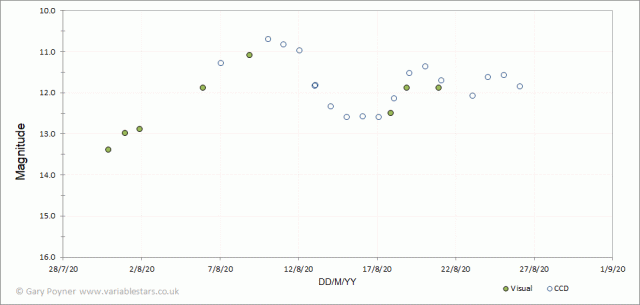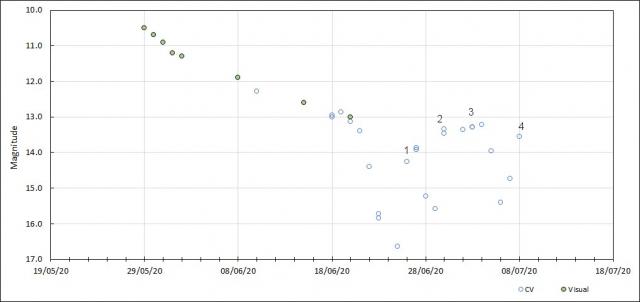Forum Replies Created
-
AuthorPosts
-
 Gary PoynerParticipant
Gary PoynerParticipantNearly 🙂 Although with all this cloud, I’m just hoping I get to see it when at it’s brightest!
The AAVSO doesn’t yet recognise the new designation (V1112 Per), although I suspect it will very soon. There are some bright comparison stars on the 3 degree (180′) AAVSO chart that observers will need to use.
Gary
 Gary PoynerParticipant
Gary PoynerParticipantOne might even try looking at it 🙂 Mag 9.5 last night (Nov 26th) and looks to be brightening further, so binocular territory once the Moon is out of the way.
Gary
 Gary PoynerParticipant
Gary PoynerParticipantIX Dra is now fading from Stewarts superoutburst. Last couple of nights…
Nov 14.82 15.3 visual
Nov 16.88 15.49CV
I’ll keep going with this one I think.
Gary
 Gary PoynerParticipant
Gary PoynerParticipantI always find it useful to plot a DSS image from VSP, especially when comparing to images taken yourself. The computer generated charts do contain the odd error (both bright and faint stars) which users should be aware of.
I use the VSP-DSS charts for both visual and CCD work. I would advise you to do the same, or at least give it a try.
Good luck,
Gary
 Gary PoynerParticipant
Gary PoynerParticipantYep, certainly in outburst Oct 22.944 15.4 visual.
Gary
 Gary PoynerParticipant
Gary PoynerParticipantI had it 15.0 visual this morning (13th).
I was hoping that it might do more (we have waited rather a long time to see it after all!). I don’t see any evidence for superhump like features in the light curve at all. Perhaps it might surprise us with a second outburtst once it’s faded further.
One of the earlier interpretations of it’s class is Recurrent Nova. Maybe?
Gary
 Gary PoynerParticipant
Gary PoynerParticipantHi Mike,
Not a lot available, but this is interesting…
https://konkoly.hu/pub/ibvs/5401/5441.pdf
Gary
 Gary PoynerParticipant
Gary PoynerParticipantGood to see reports of AY Lac coming in, and that the outburst coincided with clear sky for some people – me included. I had AY Lac varying between 13.8-14.1 visually over several hours, but after spending decades looking at empty space it was a thrill just to see it.
Gary
 Gary PoynerParticipant
Gary PoynerParticipantI measured it this morning from an image taken by COAST last night at 17.48V. I had it peaking on Sep 04 at 15.4V.
There are a quite a few bright observations in the AAVSO DB – visual 13.0-14.0 and CV 14.0-15.5. I’m sure the visual observations are mis-identification. I certainly can’t see it visually in my 51cm.
I wrote a news article on the Nova in the September VSS Circular, which included a V-band image. You can read it here.
Gary
 Gary PoynerParticipant
Gary PoynerParticipantThe Nova is now fading from it’s second maximum, very slightly fainter than the first. Most unusual. Reminds me of V5558 Sgr (Nova Sgr 2007).
Gary

 Gary PoynerParticipant
Gary PoynerParticipantNice coincidence that Tim. Many thanks for posting the image! Seems to have levelled out in brightness, but that could easily change.
Gary
 Gary PoynerParticipant
Gary PoynerParticipantObservations from last night and this morning suggest Nova Cas is rebrightening after a very short four day decline.
At this stage the light curve resembles several other Nova I have observed over the years – V1493 Aql (N Aql 1999#1), V2274 Cyg (N Cyg 2001) and the Fe II Nova V2362 Cyg (N Cyg 2006), although the time scales of fading and rebrightening are different.
The light curve below is from visual observations and unfiltered CCD from SLOOH. Thank goodness for remote scopes – the night sky here in Brum has been very cloudy of late, although I did have a forty minute gap last night (17th).
Gary

 Gary PoynerParticipant
Gary PoynerParticipantYes Lars, it looks as if it’s getting a little brighter. I had 13.0 visual in a cloud break just after dark last night (31st)
Gary
 Gary PoynerParticipant
Gary PoynerParticipantMy first opportunity to see Nova Cas ’20. In a grotty sky using the AAVSO sequence, visual 13.4 on Jly 30.938.
The first Nova (detected) in Cassiopeia since V723 Cas (Nova 1995), which is still visible around 16.5 mag.
Gary
 Gary PoynerParticipant
Gary PoynerParticipantCracking images everyone. For once I’m quite excited over a comet!
Gary
 Gary PoynerParticipant
Gary PoynerParticipantThat’s it. Thanks Jeremy. I knew it was more than 10, but couldn’t recall the object without cheating and checking in my records 😉
I’ll have a bob on eight!
Gary
 Gary PoynerParticipant
Gary PoynerParticipantAfter 41 days since it’s first outburst for 32 years, PQ And is still active with the fourth rebrightening commencing on July 7.
All except number three have been short duration events of ~1d. The third has been long in comparison ~3d. (see light curve from my own observations below)
I can’t recall the system which has had the most post outburst brightenings, but we have a way to go yet with four, so please stick with PQ And for the foreseeable future.
Gary

 Gary PoynerParticipant
Gary PoynerParticipantPQ And is undergoing it’s first rebrightening today after fading to 16.6CV on June 25. Latest observations reveal 13.45V on June 26.45 (M. Mobberley). This could be the first of several rebrightenings (or the only one), so please stick with it for the next few weeks if possible.
The field is getting slightly easier in the morning sky now, so any observations made please report them to the VSS.
Thanks and good luck,
Gary
19 June 2020 at 3:42 pm in reply to: Observer’s Challenge – Occultation of Venus by the Moon, June 19 #582664 Gary PoynerParticipant
Gary PoynerParticipantExcellent Andrew. Well done!
Alas nothing but heavy cloud here.
Gary
 Gary PoynerParticipant
Gary PoynerParticipantHello Roy,
A correction to the lunar phases in the 2020 handbook can be found here…
https://britastro.org/system/files/BAAHbk2020-p27.pdf
Gary
-
AuthorPosts
